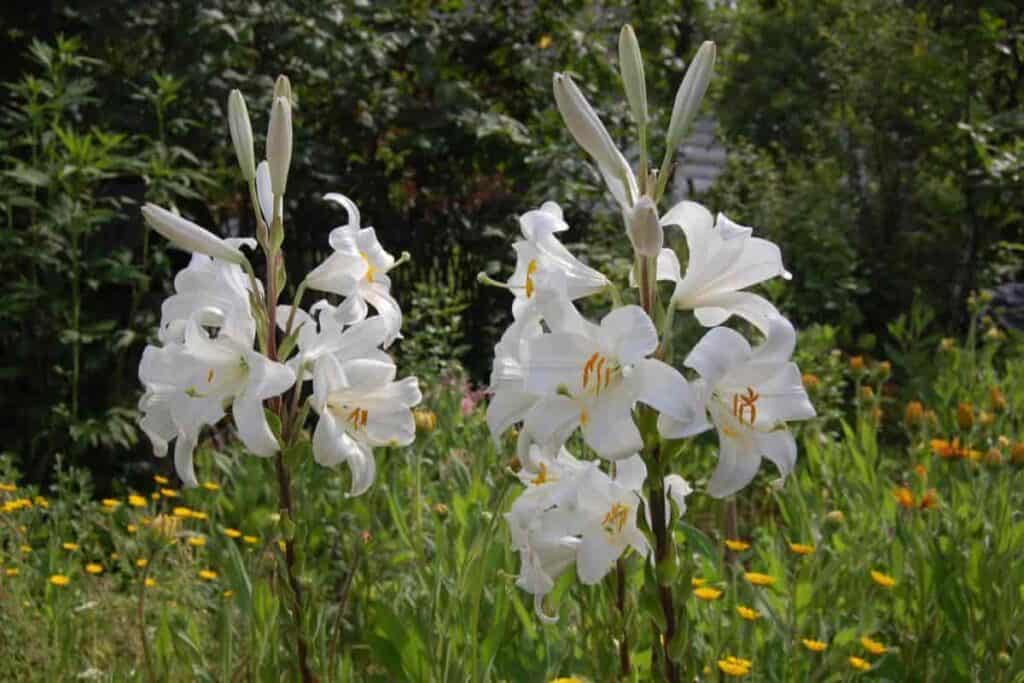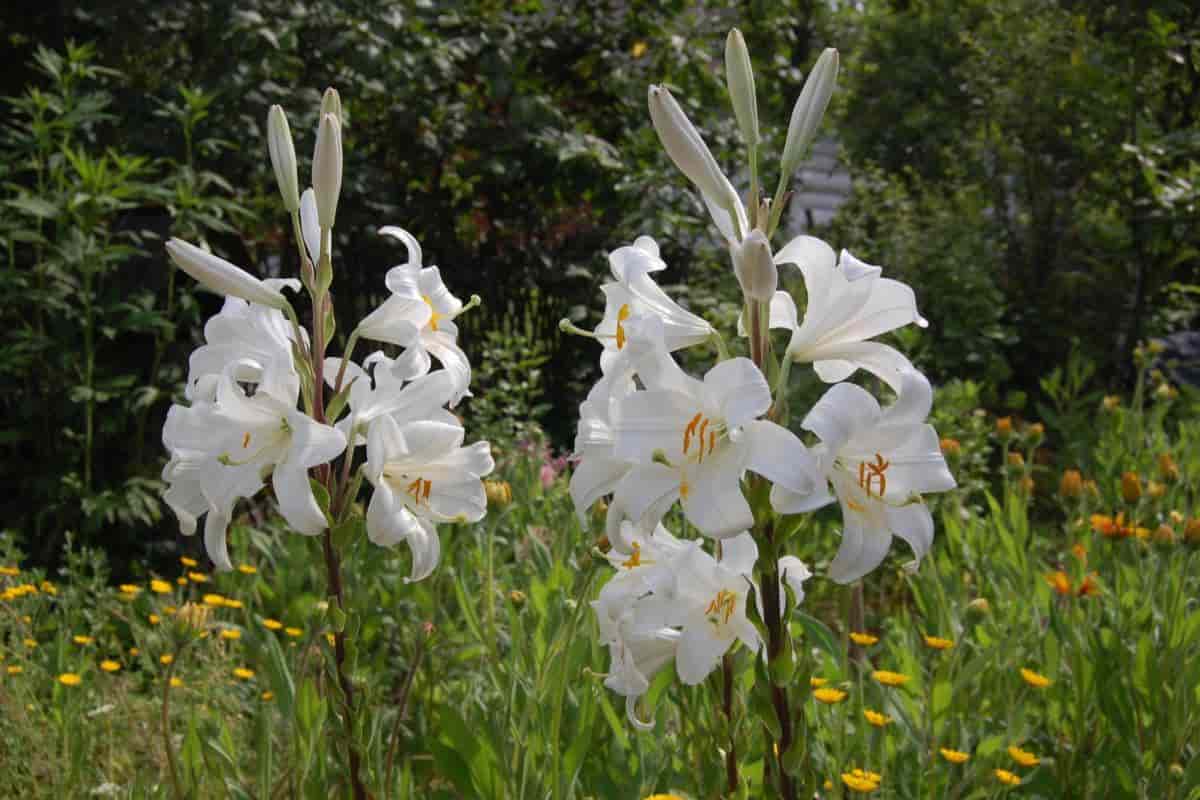Are you hesitant about growing lilies in our Mid-American climate, where drought, 100° degrees Fahrenheit, and high winds characterize most summers?
You needn’t be, for some lilies, “toughies” on my list, will grow for you as easily as petunias.

There is no pampering in my acclimatization garden, where I have tested plants for nursery workers for 20 years.
Instead, I set out lilies, say, “Here’s Oklahoma,” and wait to see what happens. If test lilies can stand Oklahoma, they can prosper in the more favored states.
Growing Regal Lily Strains
Everyone can grow a regal lily. It flowers prolifically and multiplies freely unless a late frost nips it—which has only happened twice in my garden.
Then there is the Centifolia hybrid strain (Olympic) that follows the regal, coming in mid-June in Tulsa, that is practically foolproof as it comes up too late for frost. Centifolias’ very large trumpet flowers borne on a pyramidal stalk are excellent.
Heart’s Desire lilies (de Graaff) may be mixed up in little numbers as they have most of the trumpet lilies in their ancestry, but they never fail to please with their immense bowl-shaped flowers.
During the parching summer of 1954, Heart’s Desire lilies held their leaves and seed pods—quite an accomplishment for lilies flowering in late June into July.
Golden Clarion lilies, also a strain, do not nod their heads as do the Heart’s Desire kind but carry their flowers in a regal fashion.
One finds two types of flower dominant in this strain: the elongated narrow trumpet and the bowl-shaped, both yellow.
Golden Clarion lilies begin flowering later than Heart’s Desire, and some flowers persist as late as July 10, when Havemeyer usually blooms.
Intrepid Havemeyer
Next comes the toughest lily, ‘T. A. Havemeyer.’ This lily was a chance cross that appeared in the garden of Tom Barry, New Jersey, and it was later proved to be a cross between L. Henryi, seed parent, and L. sulfurous, pollen parent.
Havemeyer is an immense flaring lily, in color cream shading through buff to an orange throat.
When well grown, it reaches 7’ feet in height and, unfortunately, inherits the weak stalk of Henryi and has to be staked. If one likes a lily outward facing, Havemeyer may be disappointed as it nods its head.
Most lily books will tell about Tom Barry losing his stock of Havemeyer during World War II because of mosaic disease. However, it is healthy in Tulsa gardens, where the original stock has been growing for many years.
If it has the mosaic disease, it doesn’t show it by mottling and is as strong a growth as the tiger lily.
Another characteristic of Havemeyer is its calm acceptance of parenthood and its magnificent progeny that come in white, through cream, primrose yellow, apricot, orange, and citron.
I have crossed and grown about 100 seedlings from Havemeyer and an unnamed seedling and have only two of the lot not garden worthy.
The great lily breeder, Jan de Graaff, once told me that the jackpot lily of the future would probably be found in someone’s backyard garden. If so, I’ll be willing to wager that Havemeyer will be in its ancestry.
My original Havemeyer lily flowered 12 years ago, is grown in full sun, and the show’s none of the “sunbonnet girl” behavior of its mother, Henryi.
In Tulsa, winter hardiness does not enter the picture, but heat resistance is an important factor, and Havemeyer takes heat 100% percent.
Formosanum Is Healthy
Another persistent lily that likes Oklahoma is L. formosanum. We raise it as it flowers from seed in its first year. It comes in early August when temperatures are in the hundreds and not much else is flowering.
This lily is used in some southern gardens as a facing for broadleaved evergreens as it is at its best singly and not grown in clumps where it’s very long trumpet would not have room to display its beauty.
Like the canary used to detect natural gas leaks, formosanum is said to be most susceptible to mosaic disease and is used to detect its presence so that expensive lily bulbs may be protected. However, it seems healthy here and is widely planted.
Some borderline lilies have not prospered as well as the ones mentioned above. Madonna lilies do not like the 6.0 pH soil of my garden, as they prefer lime.
However, Madonna does well in limestone soils if sprayed with a Bordeaux mixture during winter to protect its basal leaves from botrytis disease.
The de Graaff Mid-Century hybrids that flower here with the roses in early May lose so much of their foliage by mid-summer that they have to have their stalks cut down. However, the bulbs persist and flower each year, although not as prolifically as Centifolium and Heart’s Desire hybrids.
Lily Prima Donnas
Of the lily prima donnas, first on my list are L. speciosum and L. auratum. These beauties seldom flower the second time, although the bulbs persist and send on weak stalks that cannot mature.
The hot sun is more of a factor in their not doing so well than the mosaic disease. L. speciosum rubrum, the truly pink lily, flowered here for two years and probably would have lasted longer had it been grown in the shade.
As for the pink Centifolia hybrid, it is never pink in a hot climate. Sometimes one can see the pink of the reverse petals showing through if it is grown in deep shade, but generally speaking, it is of little value for this area.
44659 by Lula Egan Quinlan
